by Luke Greiner and Mark Schultz
September 2019
The short answer is yes. Not graduating from high school nowadays will severely limit employment opportunities, probably for life. Back when our grandparents or great grandparents were in school, it was somewhat common to drop out of school, but they often had good reason like the Great Depression and limited options. Three and four generations ago most farms relied heavily on human labor to operate, often pulling children from school to work the fields and tend to livestock, but it was frequently a matter of livelihood. Work or go broke or hungry or both.
Since those days much has changed. Our economy relies on far less labor in the agriculture industry, and opportunities for workers without a high school diploma have shifted. Workers just entering the labor force who lack this valuable accomplishment will find themselves with far fewer employment options that provide a livable wage than their grandparents or great grandparents had. The relationship between completing high school or GED and employment is evident in poverty data.
Employment opportunities depend greatly on labor market conditions, and the unique trends in southwest Minnesota give workers with the lowest levels of educational attainment a bit of a leg up.
Not only has the regional labor force seen a 2.5 percent decline since the start of this decade, a drop of 5,542 labor force participants, but the region's labor force participation rate has also seen steady declines over the years, dropping from 69.5 percent in 2010 to 68.0 percent in 2017. So it appears that part of the reason the region is seeing a very tight labor force is because fewer people are actively participating in the labor force (fewer people working or looking for work).

Given the region's current reality, many employers are finding themselves having to do one or more things to attract and retain employees. First, some are considering applicants whom they wouldn't have considered in the past, such as those with a criminal background or lack of work history. Second, some are increasing their starting wages and/or either beginning to offer benefits or increasing the benefits that an employee is eligible for. Other incentives some employers are utilizing to attract and retain employees are hiring bonuses, paid time off, and flexible scheduling. So what else can employers do to find employees to fill their job vacancies?
One additional consideration for employers is trying to attract individuals from groups that have low labor force participation rates.
| Table 1. Southwest Minnesota Employment Characteristics, 2017 | |||
|---|---|---|---|
| Characteristic | In Labor Force | Labor Force Participation Rate | Unemployment
Rate |
| Population, 25 to 64 years | 161,437 | 84.8% | 2.8% |
| Less than High School Diploma | 9,494 | 68.8% | 3.5% |
| High School Diploma or Equivalent | 47,576 | 81.4% | 2.2% |
| Some College or Assoc. Degree | 63,243 | 87.4% | 2.5% |
| Bachelor's Degree or Higher | 41,129 | 90.1% | 1.3% |
| Source: U.S. Census, American Community Survey | |||
One such group is those who do not have a high school diploma. The labor force participation rate among individuals with less than a high school diploma is markedly lower than that of the region's total labor force between the ages of 25 and 64 as well as compared to other levels of educational achievement.
Like the trend seen in the total labor force outlined in Figure 1, the labor force participation rates for the prime working age population and individuals with less than a high school diploma have both decreased since 2010 (see Figure 2). Thus, as employers are looking at applicants without a high school education to fill job vacancies, subsequently opening up opportunities for those with this level of education, fewer of these individuals are participating in the labor force over time.
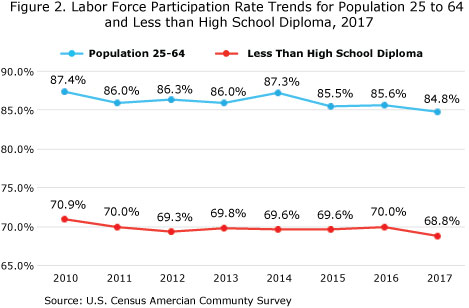
Ten years ago, when the last recession was peaking, not having a high school diploma made it very difficult to find work as employers had access to a large supply of people with high school education or higher looking to find work when demand for employees was low. In today's labor market things have changed, and many employers may find themselves having to consider individuals without a high school education to fill their vacancies. But since people without a high school diploma have a much higher chance of living in poverty, there is an opportunity amidst a tight labor market to capitalize on decreasing educational requirements and help people in poverty to get jobs or get better jobs if they are already employed.
More than one in five residents of southwest Minnesota who don't have a high school diploma live in poverty. Or put another way, people who lack a high school diploma are nearly three times more likely to live in poverty than the population that has achieved at least a high school diploma (see Figure 3).
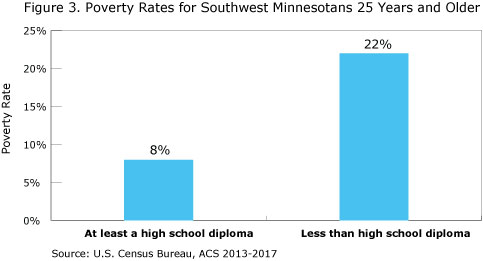
Graduating from high school is not just something to check off to move to higher levels of education. Throughout secondary school, students are gaining highly sought after employment skills. According to TalentNeuron, a software analytics company that searches job postings for keywords, the five most frequently cited skills for job openings in Minnesota are:
The skills employers are most commonly looking for are the basic foundation, and they apply to a broad variety and level of occupations. Many are the same skills that students begin to learn in our secondary schools and become reinforced and honed through work.
It's plausible that leaving school without being able to prove basic mastery of skills like communication and problem solving could limit the types of work a high school dropout can find. However, according to the most recent Census data, it's more common for people in poverty to have a part-time job than it is for them not to work at all. And even more challenging is that one in 10 people living in poverty work full-time jobs (see Figure 4). Getting a job isn't enough to get out of poverty for many workers.
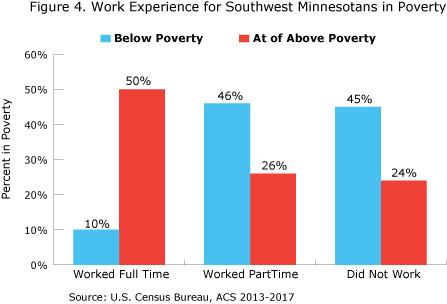
Since poverty reflects family size relative to the number of earners in a household, single parents need to earn higher incomes to be above the poverty threshold than a single person without children. This is also the main reason why a larger share of women working full-time live in poverty than men.
Almost half of family householders with low educational attainment (less than high school diploma) living in poverty are females in the region, compared to just 15 percent for men. It's a curious statistic that likely reflects the higher proportion of unmarried women or no-longer-married women to have children or other relatives living with them compared to men. Combined, unmarried men- and women-led family households make up two thirds of the families without a high school diploma that live in poverty (see Figure 5).
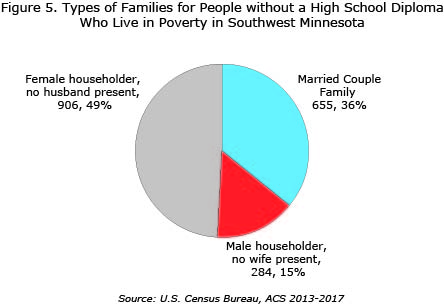
Although the barriers for workers without a high school diploma are considerable, this population appears to be benefitting from the expanding economy and tight labor market. Averaging the median wages at various education levels for each county in southwest Minnesota and examining two separate, five-year periods shows wage growth for each education level. Workers without a high school diploma have enjoyed faster wage growth than any other educational group (see Figure 6).
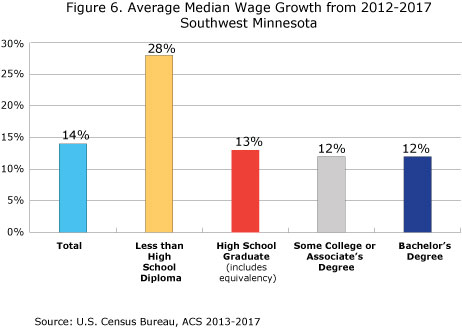
It's important for populations that face barriers in the labor market to take advantage of the current economic conditions to gain experience and skills before a downturn. Increasing the labor force participation rate for people without a high school diploma could help them gain valuable skills that could provide necessary employment stability throughout changing economic conditions.